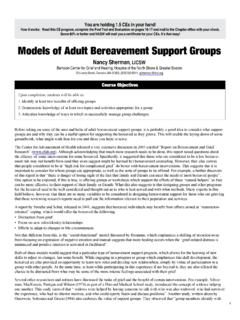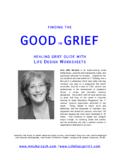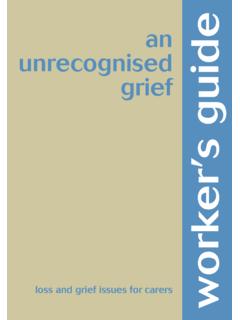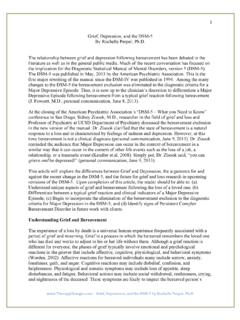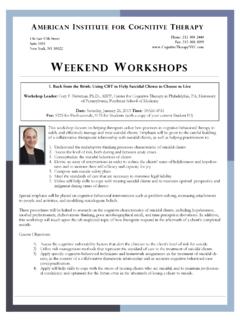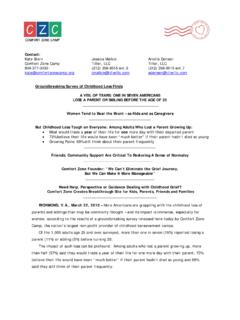Transcription of COMPLICATED GRIEF - Hospice Support Fund
1 COMPLICATED GRIEFP ublished as a public service by The Hospice Support Fund a program of New Hope Box 1839 Merrifield, VA 22116-8039M8245 CGGrief is normal. GRIEF is a common, natural response one experiences after a significant and permanent loss. GRIEF is usually caused by death of the loved one, but may be caused by the death of a pet, the end of a relationship ( divorce), or the loss of Over time, GRIEF lessens in intensity and the grieving individual returns to a normal or near normal level of functioning. COMPLICATED GRIEF , on the other hand, is abnormal. It is a state of intense, unrelenting, and disabling sorrow. COMPLICATED GRIEF is a distinct psychiatric syndrome requiring specific is normal GRIEF ?While everyone agrees GRIEF is normal, few people agree on a precise definition of normal GRIEF .
2 GRIEF is a complex reaction that includes emotional, physical, cognitive, and psychological components. One of the oldest and well-known models of GRIEF is the five-stage model proposed by Elizabeth K bler-Ross. She said a grieving individual will normally progress through denial, anger, bargaining, and depression and then ultimately come to accept the Newer research suggests many people do not experience GRIEF in a sequential order and may also experience symptoms such as emotional numbness, yearning, and because of this multistage progression, GRIEF has been viewed as something from which one recovers. GRIEF is a process, not a state. It progresses in fits and starts and may ebb and flow.
3 It is generally felt in waves of intense sadness, loss, and separation. One does not simply get over the loss of a loved one, just as one does not get over graduation or a wedding. The loss of a loved one is a major life event that will be remembered and contemplated. It will cause emotions that may be unpleasant, painful, and powerful. One hopes the waves of emotion even out into ripples over people assume the grieving person will have feelings of loss and sadness soon after the death or separation, which lessen over time as the person moves through the stages of GRIEF . In fact, most people do not experience GRIEF in this For many people, GRIEF is never really over.
4 Instead, the grieving person finds herself in one of four categories: resilience, chronic GRIEF , depressed improved, and chronic People who grieve in one of these four normal ways regain a reasonable level of functioning; people with COMPLICATED GRIEF do who experience the resilience GRIEF pattern show very few signs of GRIEF , sadness, or loss. Instead, they show a relatively low level of chronic distress or simply no outward signs of GRIEF whatsoever. This pattern was previously considered abnormal. People with this grieving style were encouraged to let out their emotions and stop trying to be strong. Careful research of the resilience pattern has revealed it is not abnormal at all.
5 In fact, 46% of people experience GRIEF in a resilience ,6,7 Moreover, people in this category have positive coping styles and healthy adjustment to the loss. They have few or no symptoms of depression at six or 18 months after the Not only is resilience the most common GRIEF pattern, but it appears to cause the least number of functional and psychological problems. Resilient grievers experience and express positive emotions and remember their lost love one fondly. Individuals in this group may experience occasional pangs of loss and continued yearning, but still function at their normal Chronic GRIEF A small percentage of people experiencing GRIEF will manifest a chronic GRIEF pattern.
6 People in this category will experience significant pangs 23of loss and sadness and sustained yearning for the lost individual. Chronic GRIEF occurs most commonly in widows/widowers who were quite dependent on their deceased spouse. Chronic GRIEF eventually resolves within four years on average as the person integrates the loss into normal Improved One in ten individuals who have lost a spouse exhibit a depressed improved pattern This pattern occurs most often when the deceased suffered a long health problem prior to death or the couple had an unhappy relationship. The depressed phase of the depressed improved pattern occurs before the loss and the improved phase begins upon death.
7 The grieving individual is able to focus on positive memories of the deceased, finds meaning in the loss of the deceased, and visualizes/experiences the benefits of living without the deceased. The loss of a loved one is the loss of a chronic stressor. Thus, death releases the grieving person from a difficult relationship or from caregiving duties associated with caring for a chronically ill loved DepressionPeople who experience the chronic depression pathway of GRIEF share an important feature with the depressed improved individual, namely experience depression before the loved one dies. Unlike people in the third group, the depression of chronically depressed grievers does not begin to resolve with the loved one s death.
8 Instead, the depression remains or worsens. The ongoing depression may last for four years or more after the loss and may reflect a long-standing mood disorder rather than simple summary, resilience, chronic GRIEF , depressed improved, and chronic depression are considered normal pathways or patterns of GRIEF . Those who experience one of these four patterns of GRIEF may experience mild functional difficulty, yet all four patterns are distinct from COMPLICATED GRIEF : Features and SymptomsApproximately 7% of those who experience GRIEF will develop COMPLICATED The rate is even higher among those who have suffered the loss of a life partner or child, especially to a violent death. COMPLICATED GRIEF is most common in women over the age of GRIEF is an unusually severe and prolonged form of GRIEF that impairs the sufferer s ability to In most cases, people with COMPLICATED GRIEF will experience persistent, intense yearning and sadness accompanied by frequent thoughts of the deceased and an inability to accept the person is gone.
9 Sufferers tend to ruminate on the factors surrounding the death itself. For example, sufferers may be angry with those they deem responsible for the death or guilty that they did not do more to prevent death or prolong the life of the Like those with post-traumatic stress disorder, people with COMPLICATED GRIEF tend to avoid situations that may evoke feelings of GRIEF or reminders of loss. On the other hand, this same person may spend inordinate amounts of time viewing photos, mementos, or belongings of the some cases, the person with COMPLICATED GRIEF has a diminished sense of self, meaning the sufferer cannot imagine a life without the lost loved one, causing the sufferer to withdraw from work, family, and social ties.
10 As a result, the sufferer s Support system is strained, frustrating family members and friends, causing them to further distance themselves from the grieving person. Thus, the sufferer s sense of isolation is most common features of COMPLICATED GRIEF are yearning for the deceased and feeling upset by memories of the deceased. In a survey of nearly 300 patients with COMPLICATED GRIEF , researchers 4identified the most common symptoms, in order of decreasing frequency:11 Yearning for the deceased (88% of those surveyed) Feeling upset by memories of the deceased (82%) Loneliness (81%) Feeling life is empty (80%) Disbelief (76%) Inability to accept the death (70%) COMPLICATED GRIEF : DiagnosisOrdinarily, psychiatrists and psychologists in the United States use diagnostic criteria laid out in the American Psychiatric Association s Diagnostic and Statistical Manual (DSM) to diagnose mental health conditions, diseases, and syndromes.
